Search Engine Optimization
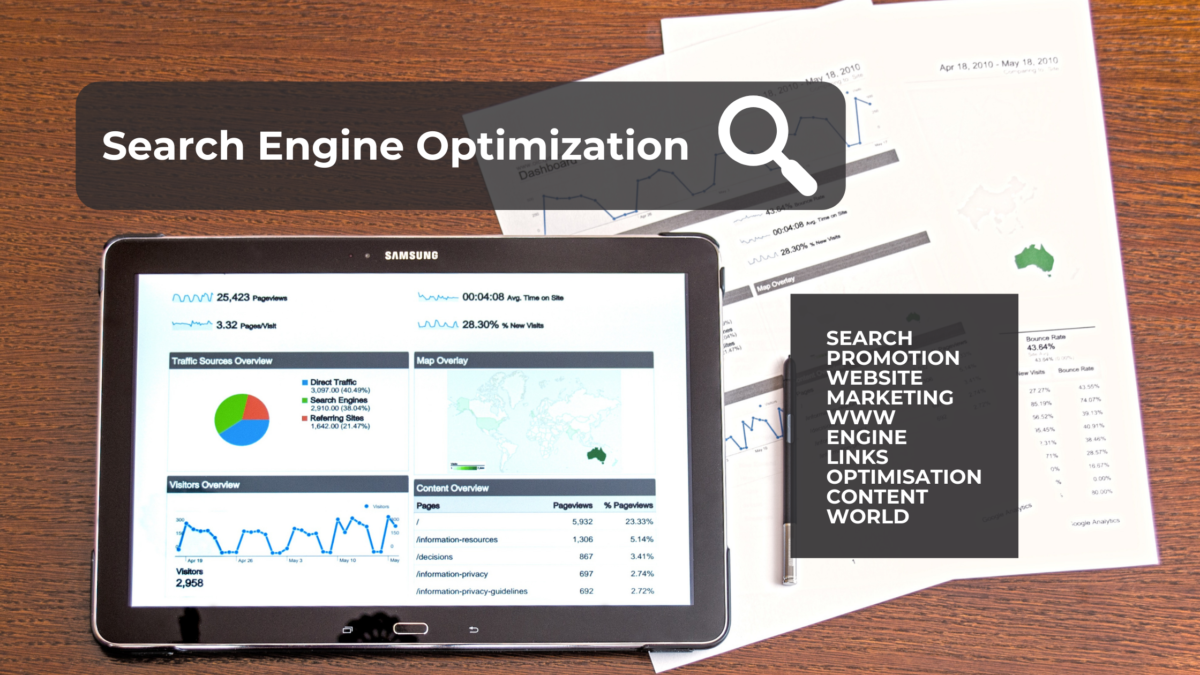
Search engine optimization is vast and complex nowadays. Do you probably know what SEO is? If not, then SEO is an art of increasing both the quality and quantity of website traffic through non-paid search engine results. If you have time and willingness to start your website SEO on the right foot, then use these simple SEO tips to improve your organic rankings.
Table of Contents
- How to do search engine optimization?
- SEO Audit
- Accessibility
- Indexability
- On-Page Ranking Factors
- Off-Page Ranking Factors
- Keyword Research
- Understand Your Competition
- Optimize Your Site
- On-Page SEO
- Off-Page SEO
- Producing Regular Content
- Build Your Social Media Networks
- SEO Audit
- How to improve search engine optimization?
- Why is search engine optimization important?
Let’s dive deep into the ocean of SEO, but you can feel free to look in any section that interests you:
How to do Search Engine Optimization?
While the concept of SEO is relatively straightforward, a newcomer to SEO should learn how does Google determines which pages to return in response to what people search for?
1. SEO Audit
At the start, you can check for issues and uncover easy-to-fix problems, analyze organic search traffic, backlink analysis, by performing an SEO audit.
SEO audit is the best way to figure out why your website is not getting the optimal SEO results. A thoroughly done SEO audit is nothing but uncovers various reasons, why does an SEO campaign not performing, to its fullest potential. Check out the advanced step-by-step checklist of SEO audit.
Website Audit consists of 4 steps in detail from an SEO perspective:
- Accessibility
- Indexability
- On-Page Ranking Factors
- Off-Page Ranking Factors
Let’s get started!
Accessibility
If search engines and users can’t access your site, it might as well not exist. With that in mind, we make sure whether your site’s pages are accessible or not.
- Robots.txt: The robots Meta tag is used to tell search engine crawlers if they are allowed to index a specific page and follow its links.
- Robots Meta Tags: The robots Meta tag is used to tell search engine crawlers if they are allowed to index a specific page and follow its links.
- HTTP Status Code: Search engines and users are unable to access your site’s content if you have URLs that return errors (i.e., 4xx and 5xx HTTP status codes). This status includes soft 404 errors and broken URL’s corresponding page.
- XML Sitemap: Your site’s XML Sitemap provides a road map for search engine crawlers to ensure they can easily find all of your site’s pages.
- Site Architecture: Your site architecture defines the overall structure of your website, including its vertical depth (how many levels it has) as well as its horizontal breadth at each level.
- Site Performance: Search engine crawlers and users both have a very limited attention span, and if your site takes too long to load, they will leave. So the sites that load quickly are crawled more thoroughly and more consistently than slower ones. The tool used to check site performance is GT Metrix.

Indexability
We identify the pages that search engines are allowed to access. Next, we determine how many of those pages are actually being indexed by the search engines.
- Site Command: The “site:” command allows us to look at indexability from a very high level. Now, we need to be a little more granular. Specifically, we need to make sure the search engines are indexing the site’s most important pages.
- Page Searches: If we found your website high priority pages in the index while performing “site:” queries then it’s fine otherwise we need to search for a specific page’s URL to check if it has been indexed. To index the website URL, we perform link building tasks include Social Bookmarking, Ping Submission, Citation Submission.
- Brand Searches: If your website appears at the top of the results, all is well with the universe. On the other hand, if you don’t see your website listed, the site might be penalized, and it’s time to investigate further. To create brand awareness, we use Brand Name in Meta Tags and perform link building strategy, Social media promotions, Content Promotion.
- Search Engine Penalties: The website might be penalized by the Search Engine Algorithm if pages are completely de-indexed or we lose significant traffic.
- Cache: Google takes a snapshot of each page it examines and caches (stores) that version as a back-up. The cached version is what Google uses to judge if a page is a good match for your query. It supports the deep crawling of your site.
On-Page Ranking Factors
- Web URL: Since a URL is the entry point to a page’s content, it’s a logical place to begin our on-page analysis.
- URL-based Duplicate Content or Canonical Tag: URLs are often responsible for the majority of duplicate content on a website because every URL represents a unique entry point into the site. If two distinct URLs point to the same page (without the use of redirection), search engines believe two distinct pages exist.
- Keyword Stuffing: You want to include keywords in your content, but you don’t want to go overboard.
- Meta Title: A page’s title is its single most identifying characteristic. It’s what appears first in the search engine results, and it’s often the first thing people notice in social media. Thus, it’s extremely important to evaluate the titles on your site.
- Meta Description: A page’s Meta description doesn’t explicitly act as a ranking factor, but it does affect the page’s click-through rate in the search engine results.
- Image ALT Tags: A picture might say a thousand words to users, but for search engines, pictures are mute. Therefore, your site needs to provide image Metadata so that search engines can participate in the conversation.
- H1 / H2 Tags: H1 and H2 tags are the main headings of the website after the website Title.
- Google Webmaster Verification: With them, you can check how your site is indexed (Webmaster Tool), get detailed statistics (Analytics Tool). This will help us to check the crawl errors of the website on a continuous basis.
- Google Analytics: Google Analytics can be a valuable tool for monitoring and tracking the efficiency of your online campaigns and get the best results in your marketing efforts. And it looks like you’re using Google Analytics to measure your website.
- Internal Duplicate Content
Off-Page Ranking Factors
The on-page ranking factors play an important role in your site’s position in the search engine rankings, but they’re only one piece of a much bigger puzzle.Website Popularity: The most popular sites aren’t always the most useful, but their popularity allows them to influence more people and attract even more attention. Thus, even though your site’s popularity isn’t the most important metric to monitor, it is still a valuable predictor of ongoing success. There is a tool named Website Grader is used. Tool: Website Grader
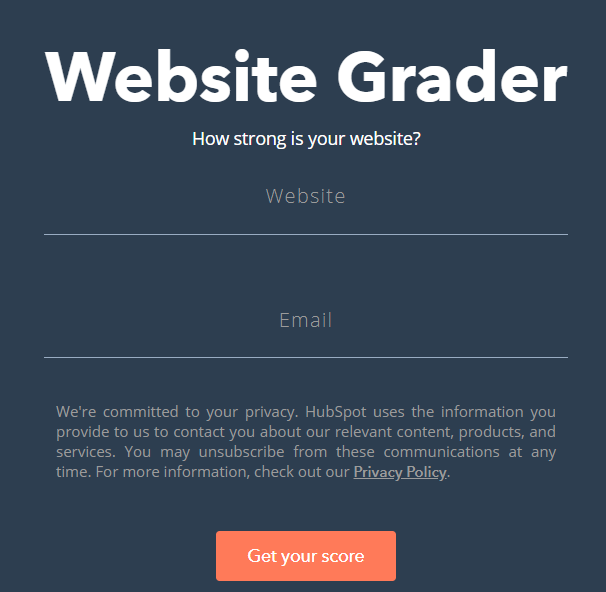
Website Grader is a free online tool that grades your site against key metrics like performance, mobile readiness, SEO, and security.
Trust Rank Checking: The trustworthiness of a website is a very subjective metric because all individuals have their own unique interpretation of trust. To avoid these personal biases, it’s easier to identify behavior that is commonly accepted as being untrustworthy. Tool: SEO Mastering
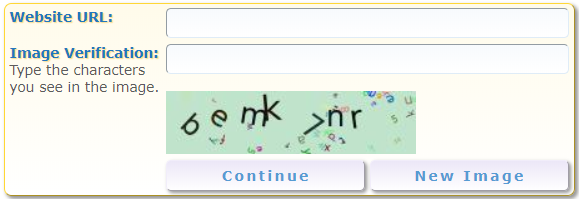
The more authoritative website will always have higher TrustRank.
Page Authority: Page Authority predicts how well a specific page will perform in the search engine rankings.
Domain Authority: Domain Authority predicts the performance for an entire domain. Tool: Moz

Moz Rank: Moz Rank represents a link popularity score.
Backlinks Checking: Website quality is largely determined by the quality of the sites linking to it. Thus, it is extremely important to analyze the backlink profile of your site and identify opportunities for improvement. Ahrefs’ Backlink Checker is a powerhouse capable of pretty much any backlink research task. We also use this tool to check the backlinks of the competitor. Tool: Ahrefs

Alexa Rank Checking – Alexa rank is a global ranking system that ranks millions of websites in order of popularity. It’s calculated by looking at the estimated average daily unique visitors and number of page views for a given the site over the past 3 months. The lower your Alexa rank, the more popular the website is. Tool: Alexa
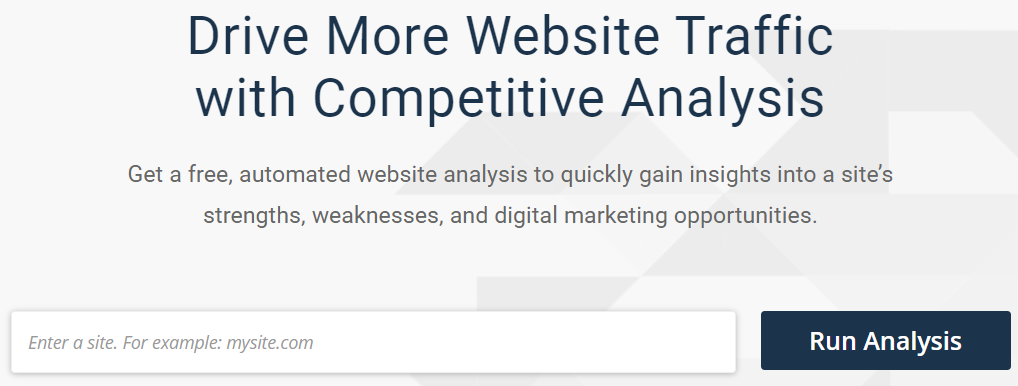
Is your website up-to-date? Yes, that’s Great!
At this point when you are done with the SEO audit, create an SEO strategy, and follow recommendations given below, & it is almost certain that you will improve your rankings and organic traffic levels.
2. Keyword Research
Let’s move ahead and figure out how keywords play an important role in SEO. SEO has evolved from a decade and Google keeps us on our toes, by regularly updating and rolling out Algorithms, but keyword research remains the very first step in the SEO.
Let’s talk about keywords. A keyword is a significant word or a string of words used to find information on search engines.
Based on Google Rank Brain algorithm, Google understands two things:
1. How the user interacts with the organic search results?
2. What is the search intent behind the query.
While there are hundreds of methods available for executing professional keyword research, but there’s no universal approach to executing keyword research. In this guide, you will get to know the step by step process of keyword research:
1. Determine the goal and niche of the website: Niche is the specific category in which your website can succeed, by targeting a particular group of people.
2. Make a list of Keywords: Analyze what kind of search terms could the people be using while looking for your service or product? Which of their “problems” does your product solve? Create a list of those terms in an excel sheet.
3. Research your keywords: Luckily, Google has made it easier with Google keyword planner tools. All you need to do is to sign up on this tool and you will move into the world of keywords.
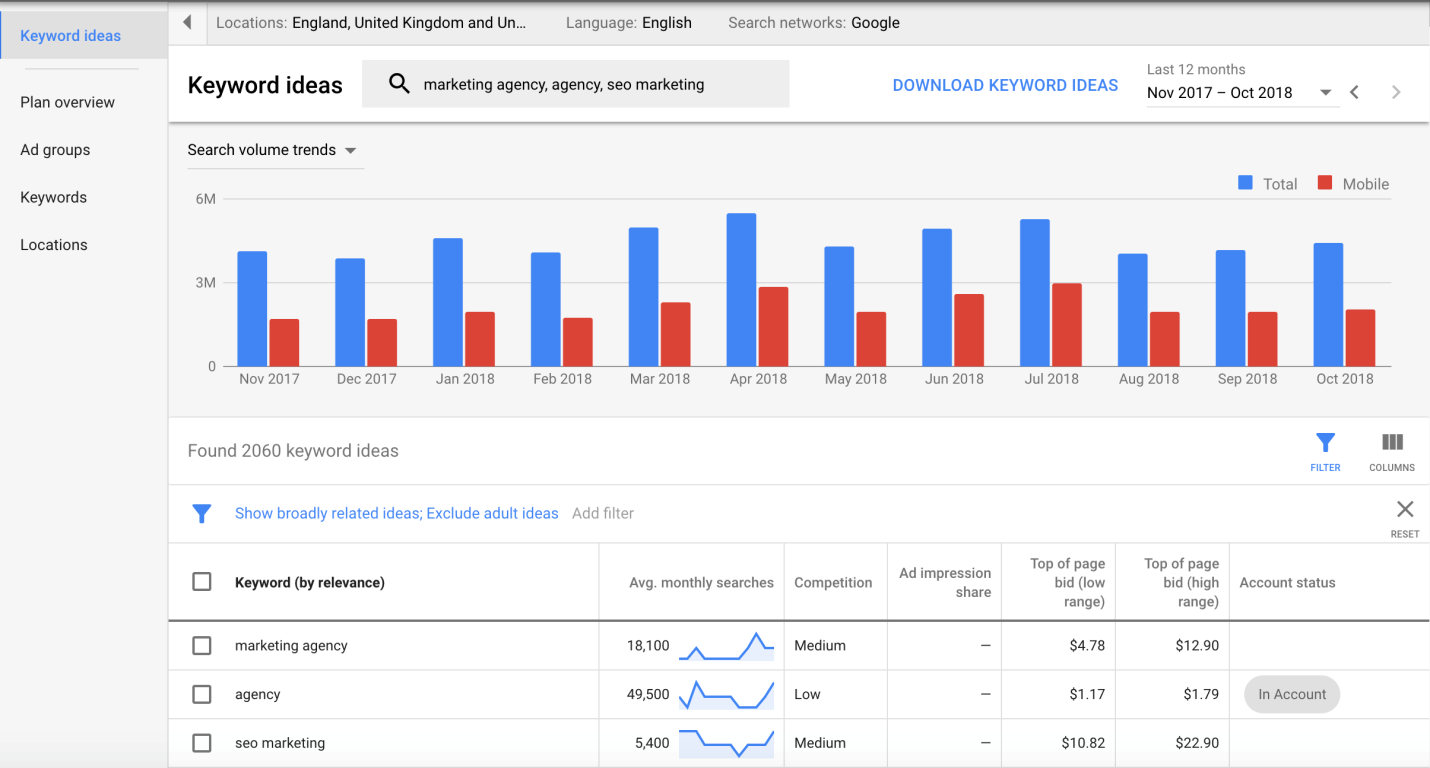
Keyword Planner is a free and most powerful tool to search for keyword ideas, see average search volume and competition of each search term.
Local SEO: Look for keywords for local areas such as specific states, cities, and other localized areas.
Another method is to spy on your competitors and find more keywords with the help of the tools.
See what keywords you already rank for: A good source of this information is a report called “Search Analytics” in Google Search Console
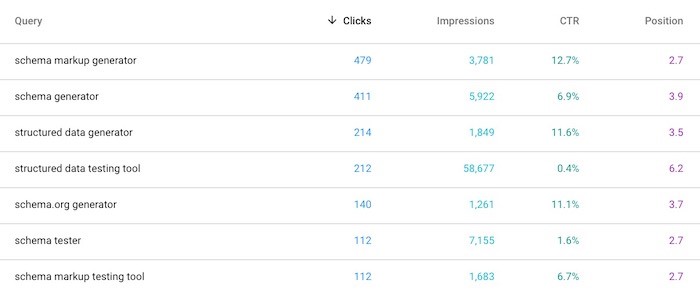
If you need more data, you can try “Organic Keywords” report in Ahrefs’ Site Explorer tool:
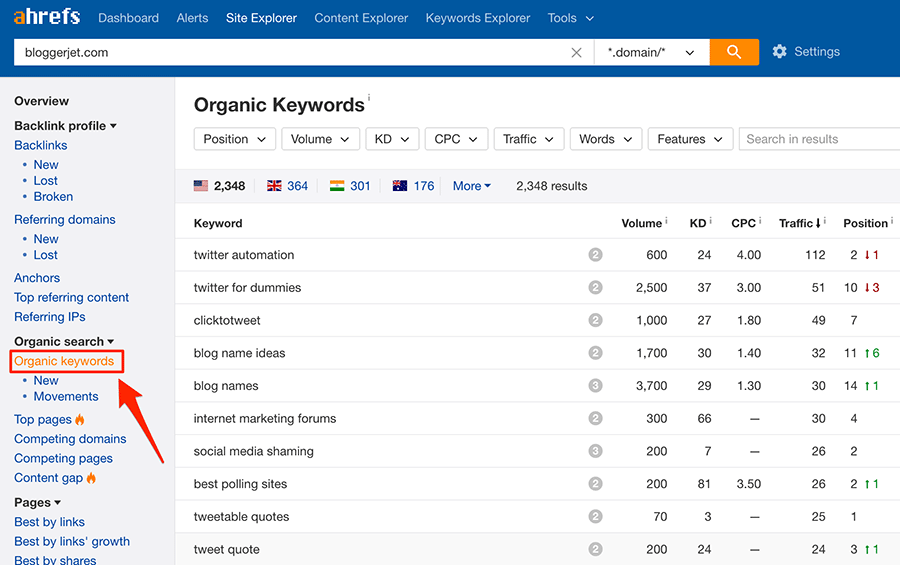
Understand the queries your audience is asking and search for keywords with one of the following: who, what, why, when, where, how. Answer The Public is one of the most popular tools to generate query-based keywords.
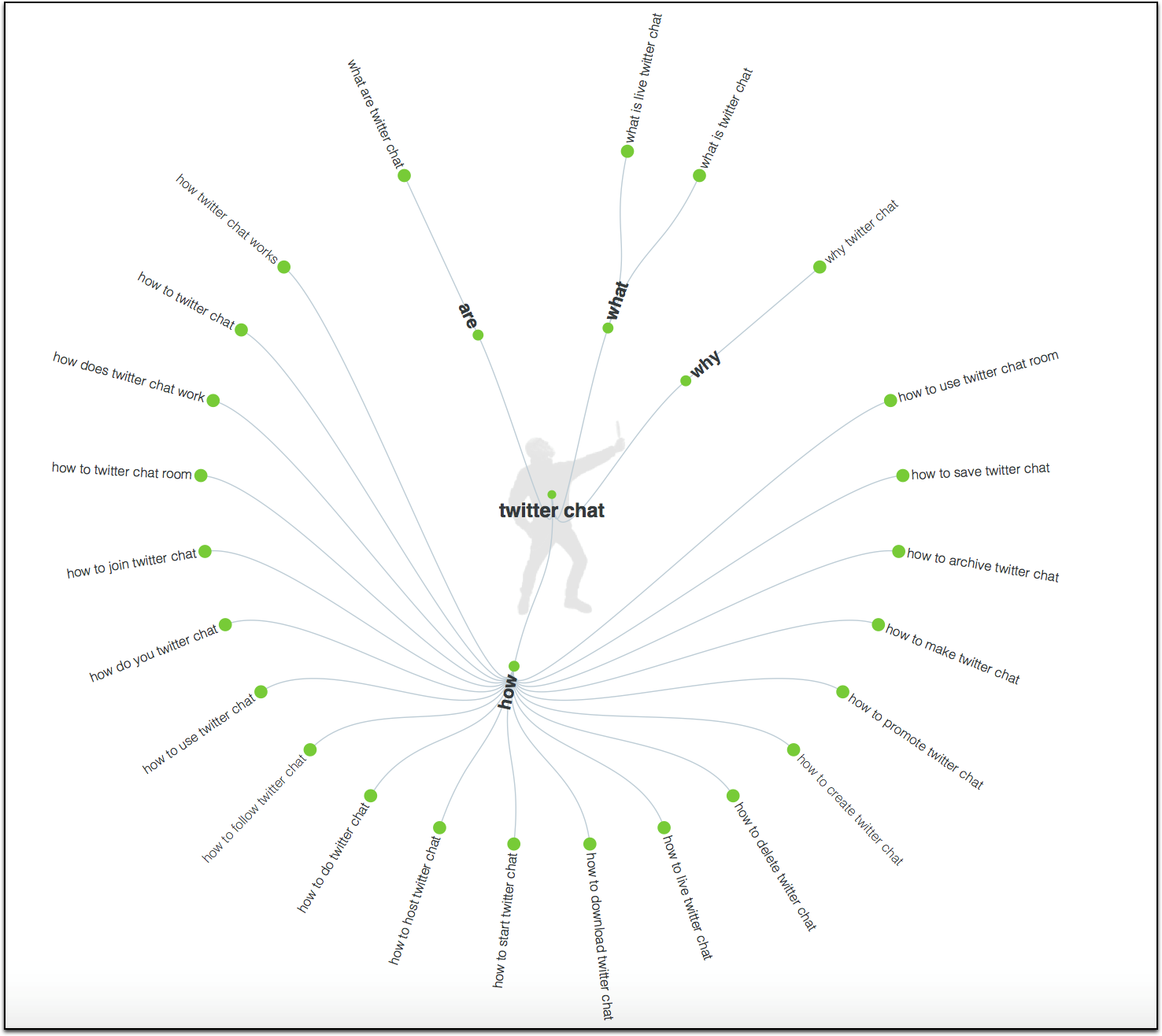
Check these tools out and add all the keywords to your list!
4. Use long-tail keywords: The head keywords used to have high competition and therefore you will need to focus on long-tail fruitful keywords with low competition and good average search volume. Moreover, long-tail keywords have a higher conversion value, as they focus more on a specific product or topic: a niche!
5. User search intent: Check out which intent your audience. Do they have informational intent (try to find information on a specific topic), commercial intent (want to research something before buying), or transactional intent (looking to buy something right now)? Try to investigate such key phrases and add your findings to your list.
Once you are done with keyword research, distribute the primary keywords and secondary keywords and get going with the content creation for your web pages stand out, in terms of quality or providing solutions.
Keyword research can be a tedious and time-consuming task, but it pays off handsomely in the long run.
3. Understand Your Competition
Find what your competitors are doing, strategic advantages, and link opportunities.
1. Spy on their keywords: Start with what keywords your competitors are targeting. The easiest way to find their target keywords is to use SEM Rush or Ahrefs.
2. Focus on their website optimization: This will help you understand how aggressively the keywords have been used; examine the Meta tags information, Internal linkings for flowing link equity through your site.
3. Content Analysis: Google gives an advantage to pages with more content. Analyze the word count of the content, uniqueness of the content, outbound links to improve the credibility of your content and it can help you build relationships.
4. Check on Google My Business Page: Get the benefits to local businesses with Google My Business. Explore the regular updates, images, reviews, and following of the competitor’s website. Create a strategy to improve your existence in local areas.
5. Analyze Social Media: If your competitors are engaging on social media, then you need to as well. The best way to find out is to look at their social accounts and see how active they are. Now, you need to step up and mirror them.
6. Analyze the Backlinks: Find the backlinks using various tools such as Ahrefs, Majestic, Open Site Explorer, Semrush. This will give a clear picture of the NoFollow to Follow a ratio of backlinks & anchor text distribution. You can create a similar strategy of backlinks and get the link opportunities.
4. Optimize Your Website
There are two major types of SEO you need for a well-rounded organic search strategy: on-page SEO and off-page SEO.
On-Page SEO
Let’s dive into On-Page SEO, the practice of crafting web pages that answer searcher’s questions.
Google uses the on-page content in order to work out what the page is about. Let’s start:
1. Optimizing URLs for SEO: Make your URLS search friendly, sensible and human readable. It can be broken down into domain name, category, sub category and page. Use hyphens for separating words and underscores for a single phrase. Implement redirect on old URL to new URL to save your value.
2. Optimizing Page Titles: Create a page title by striking a balance between readability and SEO. Using the ‘info’ command in Google, then putting in the page URL, will show your page title. Google has a limited the page title into 65-70 characters or you can say 512 pixels. Make sure you use core terms within your title. Make sure your keywords appear at the beginning to give them additional weight.
3. Optimize Page Descriptions for a better Click Through Rate: Page descriptions have a big influence on how much traffic comes through to the page. Length is once again restricted to 156 characters. Don’t forget to place keywords naturally in the descriptions.
4. Optimizing Page Headings for SEO: Header tags are an active ranking factor and can be used as both, for styling and as an SEO element. Google knows that headings are used to denote a summary of the following section, like mini titles for each section within the content. So it makes sense that Google would place extra weight on the words used within those headings. Open a primary heading tag like this
5. Optimize your Content to Rank Better: “Content is King” is an old saying but it is one of the most influential ranking factors. Try to implement keywords within the content to bridge the intent of the searcher and the information shown on-page.
Make sure the keywords should be placed naturally in the first 100 words of content.
Make sure your main keywords appear at least once, with closely matching terms being used throughout.
Use LSI keywords in the content to make sure you have keywords closely related to the search term throughout the content
Ideally, you would have at least 800 words of focused content on a page
Optimize images by implementing the image alt tag using keywords related to the information on-page.
6. Domain: Exact match domains may not carry the weight they previously did, but it’s still a strong signal the domain and page within it are highly relevant.
7. Optimize the Website for Mobile: Make your website is responsive to help people access websites via mobile devices. Google has launched the mobile-first index, which means you might rank better if you focus on mobile friendliness.
8. Speed up the Pages: The goal is to load website under 3 seconds. Use several tools to test website speed such as Google Pagespeed Insights and Pingdom. To minimize the load time use these tips:
Use a Content Delivery Network to redirect user requests to the nearest server.
Move your website to a better host. Use virtual private servers and dedicated servers over shared hosting.
Compress the size of the images
Avoid unnecessary plugins and ensure that they are kept up to date.
Reduce the number of JavaScript and CSS files. Try to group all JavaScript into one and also do so with all CSS files. This will reduce the overall number of HTTP requests. Try to group all JavaScript into one and also do so with all CSS files. This will reduce the overall number of HTTP requests.
Reduce redirects
9. Internal Linking: To push traffic around the website and offering higher trust signals to Google, internal linking is very important. Internal linking uses clear anchor text that helps to reduce bounce rate, improve your ranking for certain keywords and helps Googlebot to collect information on your site.
10. Quality Outbound Links: On the off chance that you link your webpage to another website, it is called as an outbound link. Outbound link helps visitors to navigate from pages on your website to different locales on the Internet. It is highly recommended to use nofollow links on your webpage to avoid passing ranking power which is known as link juice.
11. User-friendly navigation: Improve user navigation with breadcrumbs and user sitemaps.
Off-Page SEO
Off-Page SEO includes activities performed outside your website. Link building is a big part of this, but it goes way beyond that. Off-site SEO helps in increasing rankings, improve PageRank, and establish trustworthiness. Basically, you have to gather as many ‘votes’ as you can, so that you can bypass your competitors and rank higher. This technique follows three simple rules, i.e., get backlinks from relevant, authority, and user-friendly websites.
Let’s begin:
1. Broken Link Building: Links on authority blogs that are broken due to hosting expiry are a big advantage to your website. This is one of the biggest sources of acquiring backlinks from organic, high authority websites. Conduct a backlink analysis on a relevant website, find a broken link, contact the owner, and let them know about their dead links. Since you’re helping the website owner locate non-functional links, they might do you the favor of including a link to your website. Ideally, offer a replacement link when appropriate.
2. Social Media: Social media channels engage people and improve online reputation. Create a profile or business page of your brand and, extend your online connections. Promote your website, be responsive to recommendations and feedback, and engage with top brands.
3. Create and distribute compelling infographics: Infographics are used to attract the right audience, acquire authority links, and grow your email list. Create Infographics through tools like canva, piktochart, and search for more.
4. Guest Posting: Guest Posting is publishing content on other’s websites on a relevant topic. You can approach bloggers with the same niche with fresh, unique, relevant, and attractive content. Write guest posts to build high-quality backlinks and trigger more organic traffic to your website.
5. Q/A Submission: Think of easy-to-understand ways to communicate your brand to your customers. Participating in answering questions on sites like Quora, Yahoo Answers, Reddit, eHow can increase your link popularity.
6. Blogging: Create a website blog and feed your blog section with content based on user intent. This will give a reason for visitors to keep returning to your website and keep up to date with your latest posts, which ultimately helps you rank higher in search engine results pages (SERPs).
7. Forum Posting: Discover forums online that are related to your sites’ niche and get involved in that community. Become a part of the thread, chat with people on topics of interest by avoiding unnecessary link placement. This will help you to become an expert in your niche and then you can place a link, to your website within your signature. Great way to help the search engines crawl your site.
8. Get Listed in Local Business: Creating your business profile on local listing directories helps you, to reach a targeted audience. Submit your website to sites like; Google My Business, Google Maps, Yellow Pages, Local Business Directories, etc.
9. Article Submission: Create problem-solving and user intent-based articles. Submit them to popular article directory sites like EzineArticles, goarticles, sooperarticles, etc. and acquire some links back to your website.
10. Press Release: Promote your brand through press release submissions. Do press releases for announcements, updates, or having something important to communicate.
11. Incorporate Videos and Images: People are more engaging in motion visuals projected onto the real world that includes video and images. Share your images on sites like Flickr, Imgur, Photo Bucket, etc., and videos on YouTube, Vimeo, etc., by allowing people to comment and following a link to your website.
12. Social Bookmarking: Search engine has likeness towards social bookmarking sites. When you want to promote or index your site or webpage on search engines, you can do social bookmarking on popular sites like Diigo, scoop.it, Tumblr, mix, Techdirt, medium, and more.
13. Blog Comment: Though blog comments are an old technique Google still provides some link juice for these backlinks. Share your thoughts on blog posts relevant to your niche by writing comments and leave a link of your website organically.
14. Target Competitor’s Links: One of the most useful techniques is hunting for competitor’s links that you can acquire for yourself. Use a tool like SEMrush or Ahrefs to see all of the backlinks that your competitors are getting. Look to find their do follow backlinks. Often, there are various directories or profiles that you can create for your business.
15. Web 2.0 Sites: Creating accounts on Web 2.0 sites that allow for content creation and posting content, on those websites is a simple and powerful method. You can write hundreds of articles about your topic on other websites with links back to your own website.
16. Participate in Industry Events or Create your Events: Participating in industry-related events is a great way to positively impact off-page SEO. If your business is creating events then use it for your off-page improvement. Sign up on event sharing websites and share the details of the event and, get a link back to your site. Attendees can mention you on social media and you can get great exposure.
17. Encourage Customers to Write Reviews: Acquire positive reviews on Facebook, Google, and Yelp which gives a signal to Google that you are actively engaging, your customers and that your business is still relevant in any given field.
So, now you can acquire relevant links from high authority domains. Try to monitor your links and avoid links from harmful websites, by using disavow file. Keep your focus on quality links over quantity links.
5. Producing Regular Content
Content marketing consists of top-notch content, written for humans, and using the keywords that you’re targeting. Content that’s highly ranked, that drives traffic and leads is always user-focused, first and foremost. Use key methods to build content for your SEO campaign.
1. Target the right audience with relevant keywords: Understand the behavior of your audience (who they are, what they need, why they need, which keywords they use to find it). Research on highly searched and profitable keywords. Come up with content topics based on the targeted keywords you discovered.
2. Focus on Readability: Readability contributes to longer dwell times. When your content is understandable to more people, more people will stay longer, which will help your Google rankings.
3. Focus on Content quality: Do you provide a reason for people to spend more than a few seconds reading your webpages? Always try to offer real value, something of substance to visitors that is unique, different, and useful that they won’t find elsewhere.
4. Invest in Visuals: Try to share your information in terms of well-designed, high-quality images in your content. Researchers find that visuals have more views than articles without images.
5. Provide the Facts: SEO content is highly based on research. You can differentiate your content by providing supporting facts, sources, and data in your content.
6. Build Your Social Media Networks
Social Media has a big role in helping companies get their content in front of a larger audience. Enhance your brand’s SEO performance through social media that leads to many things that benefit SEO, including more backlinks, improved engagement signals, and more owned SERP real estate for branded queries. The most popular social media platforms are Facebook, Youtube, Instagram, Twitter, LinkedIn.
1. Backlinks: Sharing your blog posts links will give you maximum exposure, meaning your link becomes more of a linkable asset. Making use of these backlinks on various reliable social media platforms can improve the page ranking of your website in search engines.
2. Social media profiles and search engines: Social Media channels appear among top results. Social channels are more personal than websites and most consumers will prefer visiting your social media profile before they visit your website to get a better sense of the brand’s personality.
3. Social Media content Indexed quicker: Use social media to get your new and fresh content based webpages indexed by Google faster. This gives Google the signal that there is a page that needs to be crawled and re-indexed.
How To Improve Search Engine Optimization?
When your consumers are searching for you online then how you can stay away from your marketplace. That’s the reason every business owner has its own website to make the reach of its customer easy. But not every website gain that popularity and to improve your reach online, you need to focus on various aspects of SEO. Use important tips to increase your SEO results.
Improve Page Loading Speed
Google has indicated site speed (and as a result, page speed) is one of the signals used by its algorithm to rank pages. The purpose is not only to fulfill the need of Google but to give a better user experience.
1. Enable compression: Resize the CSS, HTML, and JavaScript files that are larger than 150 bytes with the help of file compression software, Gzip.
2. Optimize CSS, JavaScript, and HTML: Remove spaces, commas, and other unnecessary characters, code comments, formatting, and unused code can increase your page load speed.
3. Try to Avoid Redirects: Avoid page redirect to another page. Each redirect takes additional time waiting for the HTTP request-response cycle to complete.
4. Leverage browser caching: Sometimes the browser takes a lot of time to load the entire page. Use a tool like YSlow to see if you already have an expiration date set for your cache.
5. Remove render-blocking JavaScript: Browsers have to build a DOM tree by parsing HTML before they can render a page. If your browser encounters a script during this process, it has to stop and execute it before it can continue.
6. Use a content distribution network: Use networks for servers that are used to distribute the load of delivering content.
Creating High-Quality Content
Content is highly responsible to drive more traffic to your website and increase its popularity. Create FRESH content ideas which will improve the Dwell time and reduce bounce rate. This will impact your SEO ranking in a positive manner.
Optimize Images
Images play an important role in content creation. Though Google finds it difficult to understand what the image is all about? So, images should be optimized properly in terms of format, size. Resize or compress your images to optimize them. You can add alternate text or “ alt” text to images.
HTTPS
Get an HTTPS certificate from a certification authority that verifies the ownership of the web address. Users are becoming savvier with how they browse and share information. With privacy becoming a main concern of many online users, maintaining a secure website is key. Make sure crawlers can read your certificate in robots.txt files. Avoid using the noindex meta tag to ensure search engines are able to index your pages.
Sitemap
The sitemap is the blueprint of the website that has the architecture of the site, valuable metadata of the pages listed in the sitemap, and specific types of content on the pages of the website. XML sitemap gives a signal to Google to count the pages included in the sitemap to be of high-quality and worthy of indexing.
Backlinks
Yes, backlinks have major support to the websites. Search Engine count votes from high-quality backlinks from high authority sites. The backlink strategy is already discussed above.
Canonical Tags
These are used if the website has duplicate pages. You add this tag to help search engines identify which URL to consider as the master page among the duplicates.
Mobile Optimization
Optimize your website for mobile and make it responsive to all types of screens and orientations. Avoid using FLASH. The text should be clear and legible. Minimize intrusive ads and try to use ads at the bottom of the page.
Duplicate Content
Inspect your site for duplicate content. Duplicate content confuses users as well as search engines. Use the rel=” canonical” tag to specify which URL serves as a copy of the original and set up a 301 redirect. Use unique content for your webpage and metadata.
Use Appropriate Language
Understand the difference between American and British English language in terms of spelling, word usage, and expressions. Use the tool Grammarly to keep on checking for grammatical and spelling errors, proper punctuation, word choice, and style when writing. Grammarly has language preference – American English, British English, Canadian English, and Australian English.
Why is Search Engine Optimization Important?
SEO is a powerful tool for the success of your business in the world of the Internet. If your businesses have not launched a website then you are missing out on big opportunities that would benefit you. You are losing money every day if your website is not optimized in the search engines. SEO has that capability to provide an exceptional, return on investment and that too at a low cost.
Here are some of the reasons why SEO is important for online success:
Building a Brand
SEO increases your brand awareness and equity. “Awareness” is the first phase of the funnel where visitors may not always be ready to purchase. SEO create awareness among visitors to your services, they might consider in the near future. Establishing a brand as an authority takes patience, effort, and commitment, but also relies on offering a valuable, quality product or service that allows customers to trust a brand.
SEO pulls-in quality traffic
SEO can help your quality target audience find your site because people are actually searching for the problem you solve. Search traffic is already interested in your products and services.
Drive more traffic
SEO gets you free organic traffic and a good number of targeted visitors to your website. By positioning yourself on search engines, you are positioning your business to win more conversions.
SEO builds trust, authority & credibility
People trust Google. Google should trust your website to rank higher. If you gain trust and credibility, your website will earn authority, but authority doesn’t come easy. SEO provides valuable information on the website in terms of content, Meta tags, HTML tags, and backlinks signals to search engine.
SEO improves user experience
The strategy that works behind user experience is to provide relevance to Google’s users. SEO fulfills the criteria of relevance with quality content and help a website rank higher on search results. SEO is based on user intent and solves user queries. Google has learned how to interpret a favorable or unfavorable user experience, so you have to be consistent in delivering content to customers through the website blogs.
SEO Is Relatively Cheap
When we talk about marketing, yes it costs money! Every investor has the personal beliefs and requirements of its business. And yes, everyone wants results faster. When you compare other online marketing strategies then SEO would be considered low cost than others. Good SEO implementation will hold water for years to come. Paid search marketing benefits you for a shorter time but only till you keep on paying for results. Once you stop, it won’t last. SEO converts more efficiently.
Long Term Strategy
SEO is an ongoing process that revolves around trends and changes. SEO promises to give you long-term results as compared to most other advertising techniques. To maintain the visibility of your website on SERP, you have to be consistent with SEO for a longer time. If SEO is done correctly, then it will keep your website on top of SERP and the results you get can last for years. This can have high SEO importance for small businesses that are struggling to succeed.
SEO is Quantifiable
SEO provides lots of analytics data for your website. You can use data to plan your future strategies by analyzing which search keywords are the most valuable to your business. SEO can measure your conversions and the source of conversions. SEO also measures the progression of your website rankings and organic traffic.
Easy to Push Your Audience Down the Funnel
Customers do their research. That’s one of the biggest advantages of the internet from a buyer perspective. SEO undoubtedly impacts the buying cycle in a positive way when done right. SEO makes a correlation with the audience at the top of the funnel. SEO starts with the first phase of the buying cycle and it helps to maintain the audience on your website by offering valuable content and useful information. Local SEO enhances visibility and lets potential customers find the answers, and the businesses providing those answers.
SEO Improves Your Overall Marketing ROI
Every marketing campaign urges for investment and a good amount of, investment in terms of time and money can bring a great return on investment. Paying for just a few months won’t guarantee the stability of the results. A long-haul plan will bring you organic traffic, maximum clicks, and business revenue.

